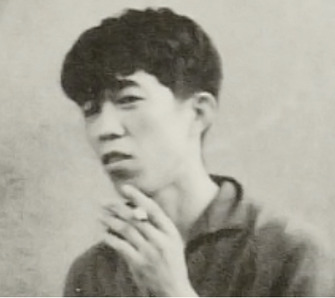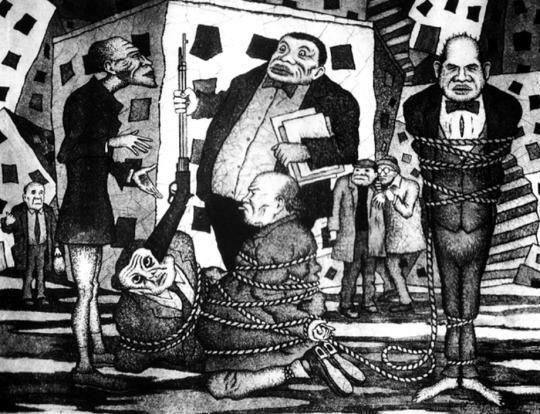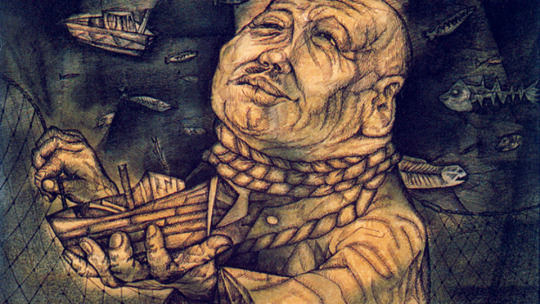Text
On Kawara (1932-2014)
On Kawara, a Japanese born artist based in New York, became a household name after gaining sensational response from his contemporaries for his graphic images. He came to stand for the new generation of social realism which was determined to confront the reality of Japan’s postwar society with a vision unclouded by the older generations' nostalgia for the prewar past.

The Bathroom series, 1953
In these pencil sketches, the bathroom is a distorted, claustrophobic space filled with scenes of murder, dismembered bodies and Matricidal images. The naked bodies of wide-eyed men and women are cut into pieces with various body parts floating inside a neatly tiled bathroom.
It is not difficult to see that Kawara's drawings are associated with the tumultuous state of the Japanese nation during his time. A close examination of the conflict betwen the subject of brutality and the formal strategy of indifference (the subjects seem indifferent to their their own murder) allows us to infer that the disrupted representation of Kawara's Bathroom series echoes the psychological effect of the nuclear explosion and its social aftermath. Some images can be seen below.


#The Decoy#—the humiliation of occupation#collusion in a neighboring war#political entrapment#and social inequality#though some of the works are highly allegorical.#Some of his works are shown below.#The unattractive head depicts Kishi Nobusuke#who became prime minister in 1957 and negotiated the renewal of the security treaty in 1960. Kishi was imprisoned as an accused war crimina#but never brought to trial.#In several works#Ishii set his sights on specific targets#such as war profiteers in his untitled painting below.#japan#japanese history#art#literature#tumblarians#writers#japanese#japanese culture#japanese art history#art history#art exhibition#illustration#contemporary japanese art#post war#art revolution#world war 2#world war second
0 notes
Text
ISHII SHIGEO (1933-1962)
Ishii Shigeo became a reportage painter by exploring his country’s uneasy subconscious. Though he studied classical painting as a teenager, he developed a distinct style of social critique in his oil paintings through his association with Ikeda Tatsuo, Nakamura Hiroshi, and other reportage and avant-garde painters. He died at age 28, leaving a lot of his work neglected.
"The force driving any individual attempting to create a work of art in our modern world must be his desire to revolt against the inhumane mechanism of his society in order to transform it. Without that craving it is impossible to create art."
Shigeo's dominate works fall under a series of over 15 paintings, collectively named as "Violence" by him; The series include, “The Room,” “Floating Skulls,” “Pleasure" and so on.
His intention was to map the basic contradictions of postwar Japan—the humiliation of occupation, collusion in a neighboring war, political entrapment, and social inequality, though some of the works are highly allegorical.
Some of his works are shown below.
"The Decoy"

The unattractive head depicts Kishi Nobusuke, who became prime minister in 1957 and negotiated the renewal of the security treaty in 1960. Kishi was imprisoned as an accused war criminal between 1945 and 1948, but never brought to trial.
In several works, Ishii set his sights on specific targets, such as war profiteers in his untitled painting below.

#japan#japanese history#art#literature#tumblarians#writers#japanese#japanese culture#japanese art history#art history#art exhibition#illustration#contemporary japanese art#post war#art revolution#world war 2#world war second#world war ii#world war two#Postwar period#katsuragawa#zennei bijutsukai#recommendeds tag#history#post war art history#world history#art blog#YAMASHITA KIKUJI
1 note
·
View note
Text
IKEDA TETSUO (1928-2020)
Ikeda Tetsuo, An Ex-kamikaze, who then resolved to focus on art and joined an Avant-garde group where he was told that "all art should further the cause of the revolution".

The Uchinada Series.
Tetsuo spent a week in a fishing village called Ushinada, where he witnessed the struggles of the protestors fighting to keep their beaches from being seized to make a firing range and fighting to not lose their livelihood.
He portrayed these struggles in the following paintings.

"Fishermen's Boss"

"The Haul"
#japan#japanese history#art#literature#tumblarians#writers#japanese#japanese culture#japanese art history#art history#art exhibition#illustration#contemporary japanese art#post war#art revolution#world war 2#world war second#world war ii#world war two#Postwar period#katsuragawa#zennei bijutsukai#recommendeds tag#history#post war art history#world history#art blog#YAMASHITA KIKUJI#The Tale of#New Japan
2 notes
·
View notes
Text
NAKAMURA HIROSHI (1932- )
Nakamura Hiroshi is an artist involved mainly in depicting conflicts between protestors and the US Military.

In one such depiction , he shows the confrontation between protestors and the Military in a place called Sunagawa, where the protest was against the military trying seize their land.
Below are his initial sketches from which he ultimately made a bigger more detailed oil painting



And Below you will find his final oil painting complete with motifs that depict the struggles.

He added imaginary elements to the picture as well, such as the priest standing in solidarity with the protestors.
#japan#japanese history#art#literature#tumblarians#writers#japanese#japanese culture#japanese art history#art history#art exhibition#illustration#contemporary japanese art#post war#art revolution#world war 2#world war second#world war ii#world war two#Postwar period#katsuragawa#zennei bijutsukai#recommendeds tag#history#post war art history#world history#art blog#YAMASHITA KIKUJI#The Tale of#New Japan
1 note
·
View note
Text
YAMASHITA KIKUJI
(1890–1973)
“The Tale of
New Japan,”
Direct critique of both the continued U.S. military presence and the Japanese who profited from collaborating.
Initial sketch,

Final Painting,

#japan#japanese history#art#literature#tumblarians#writers#japanese#japanese culture#japanese art history#art history#art exhibition#illustration#contemporary japanese art#post war#art revolution#world war 2#world war second#world war ii#world war two#Postwar period#katsuragawa#zennei bijutsukai#recommendeds tag#history#post war art history#world history#art blog#YAMASHITA KIKUJI#The Tale of#New Japan
1 note
·
View note
Text
Hiroshi Katsuragawa (1924 - 2011)
Born in Sapporo, Hokkaido, Hiroshi Katsuragawa was an artist closely associated with post war avant-garde movement in Japan. In 1949, he joined the art collective Seiki no kai, the aim of which was to inspire artistic and political discussion about Japan's participation in world war II through their published and hand distributed pamphlets. The same year he produced the cover art of the collective's first collection of poems.
In the year 1952, Katsuragawa joined the Zen'ei Bijutsukai (前衛美術会 Avant-Garde Art Society), formed in 1947 and closely aligned with JCP. The same year, Katsuragawa and other artists of the art society were ordered by JCP to go to Ogōchi, a farming village in the mountains west of Tokyo that was to be obliterated by a dam, and support the formation of "mountain village guerrilla squads" (sanson kōsakutai) by mobilizing farmers' discontent with the dam construction in order to foment a violent communist revolution.
The activists who went to Ogōchi ultimately failed to convince farmers to start an uprising and felt betrayed when JCP suddenly turned their backs on their commitment to immediate revolution. After that the Zen'ei Bijutsukai slowly became inactive and stopped holding their annual exhibitions.
In 1953, Katsuragawa helped form a new "Young Artists' Alliance" (青年美術家連合, Shōnen Bijutsuka Rengō) with like-minded artists such as Hiroshi Nakamura, On Kawara, Tatsuo Ikeda, and Kikuji Yamashita.
Katsuragawa continued to produce socialist realist art for exhibitions well into the 60s and 70s supporting anti-war and anti-imperialism stances.
in the 2000s, a retrospective solo exhibition of Katsuragawa's works was held at Art Gallery Kan in Tokyo. The 2010 documentary film about postwar Japanese anti-war art, ANPO: Art X War, by american filmmaker Linda Hoaglund prominantly features his works. the Same year, two more retrospective exhibitions of his work were held.
He died of pneumonia on 16th October, 2011

An illustration of Katsuragawa's work from his days as a part of the Seiki no Kai.
#japan#japanese history#art#literature#tumblarians#writers#japanese#japanese culture#japanese art history#art history#art exhibition#illustration#contemporary japanese art#post war#art revolution#world war 2#world war second#world war ii#world war two#Postwar period#katsuragawa#zennei bijutsukai#recommendeds tag#history#post war art history#world history#art blog
1 note
·
View note
Text
Immediate post war Avant Garde
Immediately after Japan's defeat in the world war, many artists fell under the influence of, and some even joined, the Japanese Communist Party. The JCP soon came to dominate major art societies and exhibitions in Japan, as a result the predominate form of art in this period was socialist realism that showed the suffering of the poor, and the nobility of the working class. This was in line with the JCP doctrine that all art should serve the purpose of advancing the cause of the revolution. The JCP even sent artists to mountains to produce social realist art in support of groups that were attempting to instigate a violent revolution in Japan.
#Japanese art history#art#history#japanese history#contemporary Japanese art#tumblarians#contemporary Japan#art blog#art style#art history#japan art#japan core#writers#post war#Post war art history
3 notes
·
View notes